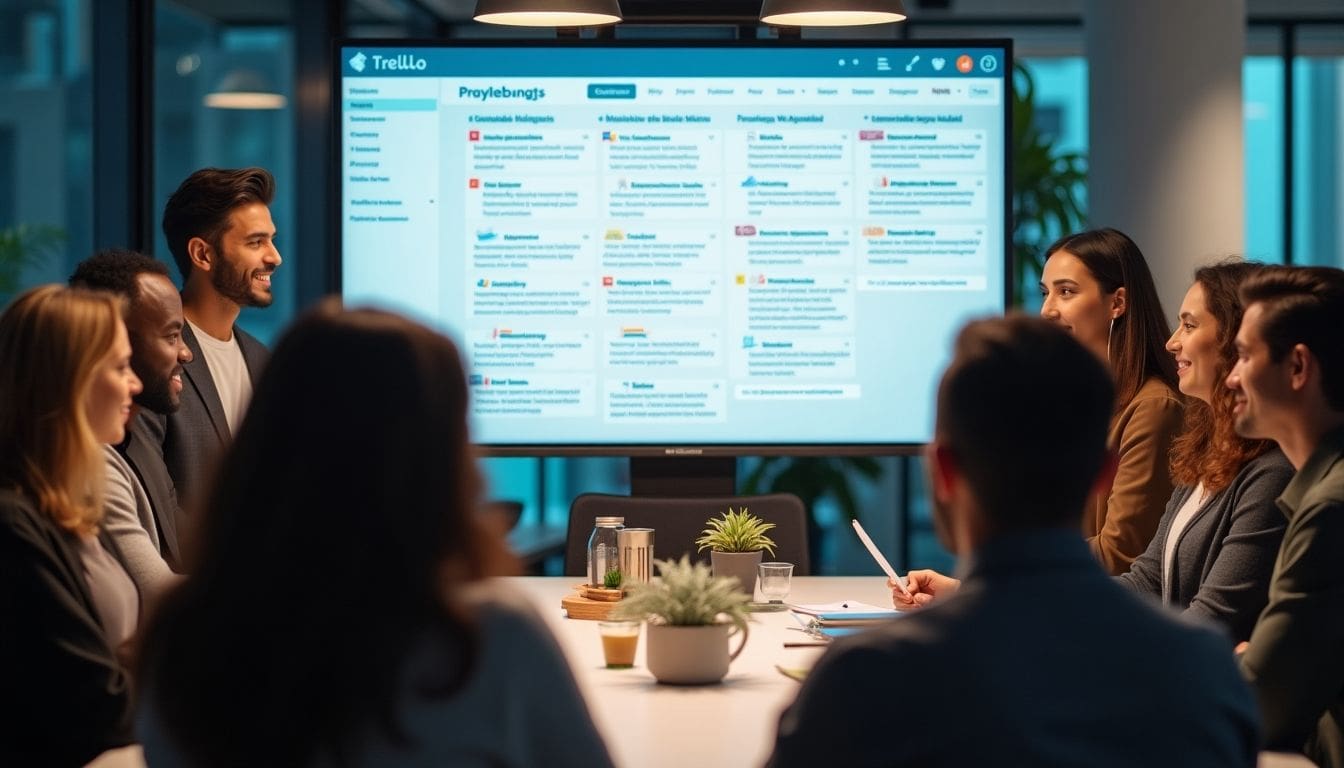Facilitative leadership is a fresh approach to leading teams, and it’s changing the way organizations think about success. Instead of relying on traditional top-down methods, this style focuses on collaboration and empowering team members to contribute their best. When done right, it creates an environment where everyone feels heard, valued, and motivated to work together to achieve common goals. In this article, we’ll explore the key skills and strategies behind facilitative leadership and how they can help you build a high-performing team.
- Facilitative leadership emphasizes collaboration over control, making teams more engaged and effective.
- Building trust through active listening and transparency is essential for team success.
- Inclusive decision-making encourages diverse ideas, leading to better solutions.
- Emotional intelligence helps leaders manage conflicts and support their teams.
- Using feedback as a tool for growth keeps teams improving and aligned.
Mastering the Art of Facilitative Leadership
What Sets Facilitative Leadership Apart
Facilitative leadership isn’t about barking orders or micromanaging every detail. Instead, it’s about creating an environment where people thrive and contribute their best ideas. At its core, this approach blends participative leadership and servant leadership strategies, emphasizing collaboration over control. The leader’s role is to guide the process, not dictate the outcomes. Think of it as being the architect of a space where innovation and teamwork naturally flourish.
Here’s what sets it apart:
- Active listening: Facilitative leaders don’t just hear—they engage. They paraphrase, ask questions, and ensure everyone feels understood.
- Neutral facilitation: They manage discussions without bias, ensuring every voice is valued.
- Empowering others: By handing over decision-making power, they build a sense of ownership within the team.
The Core Principles of Facilitative Leadership
Facilitative leadership operates on a few key principles that align with effective team facilitation strategies:
- Shared Purpose: Every team member understands and aligns with the overarching goals.
- Inclusivity: Diverse perspectives are not just welcomed—they’re sought out.
- Adaptability: Leaders adjust their approach based on the team’s needs and dynamics.
- Transparency: Open communication builds trust and eliminates hidden agendas.
- Reflection and Learning: Teams regularly evaluate their processes and outcomes to improve continuously.
A facilitative leader doesn’t just focus on results—they ensure the journey to those results strengthens the team’s cohesion and capability. The essence of facilitative leadership is captured in these core principles, which guide effective team facilitation.
Why Facilitative Leadership Drives Team Success
Facilitative leadership is a game-changer for organizational leadership development. Here’s why:
- It boosts engagement: When people feel heard, they’re more invested in the outcomes.
- It reduces conflict: By managing differing opinions constructively, teams can turn disagreements into opportunities for growth.
- It fosters innovation: Encouraging open dialogue and brainstorming leads to breakthroughs that hierarchical structures often miss.
Facilitative leadership also supports teams in the pursuit of shared visions and goals, fostering collaboration and self-management.
Challenge yourself: The next time you’re in a leadership role, resist the urge to provide all the answers. Instead, ask questions that spark deeper thinking and collaboration. You’ll be surprised at the solutions your team can generate.
Facilitative leadership isn’t just a skill—it’s a mindset shift. It’s about moving from “me” to “we,” from control to collaboration. And when done right, it transforms not just teams, but entire organizations.
Building Trust as the Foundation of High-Performing Teams

Facilitative leaders connect with their teams to establish trust and foster engagement, laying the groundwork for collaboration and effective communication.
The Role of Active Listening in Leadership
Trust starts with making people feel heard. Active listening is more than nodding along; it’s about truly absorbing what someone says and showing them their voice matters. When leaders listen actively, they create a ripple effect across the team. Employees feel valued, which boosts morale and collaboration. Here’s how to make it happen:
- Pause and focus: Put down your phone, close your laptop, and give your full attention.
- Ask clarifying questions: This shows you’re engaged and ensures you understand their perspective.
- Summarize what you heard: Reflect their words back to them—it demonstrates you’re on the same page.
When you prioritize listening, you build a foundation for trust that strengthens every interaction.
How Transparency Fosters Team Loyalty
Transparency isn’t just telling people the good news; it’s about being upfront, even when the truth is uncomfortable. When leaders prioritize transparency and honesty by openly sharing goals, challenges, and decisions, they create a culture where trust can thrive. Consider this framework for transparency:
- Explain the “why”: When making decisions, share the reasoning behind them.
- Own your mistakes: Being honest about errors shows humility and builds credibility.
- Share progress regularly: Whether it’s successes or setbacks, keeping the team informed fosters a sense of inclusion.
Transparency transforms teams. It shifts the dynamic from “us vs. them” to “we’re in this together.”
Creating a Culture of Psychological Safety
Psychological safety is the secret sauce of high-performing teams. It’s the belief that no one will be punished or humiliated for speaking up with ideas, questions, or concerns. Without it, innovation and collaboration die. Here’s how to create it:
- Model vulnerability: Admit when you don’t know something or when you’ve made a mistake.
- Encourage risk-taking: Celebrate bold ideas, even if they don’t work out as planned.
- Address toxic behavior immediately: A single unchecked ego can poison the well.
Psychological safety isn’t a luxury—it’s a necessity for teams aiming to excel. When people feel safe, they bring their full selves to work, and that’s when the magic happens.
Empowering Teams Through Inclusive Decision-Making
Encouraging Diverse Perspectives for Better Outcomes
Inclusive leadership is about ensuring every voice is heard, especially those that often go unnoticed. Effective group decision-making thrives on diversity. When you bring together people with varied backgrounds, skills, and viewpoints, the team doesn’t just solve problems—they find creative solutions that no single perspective could achieve. Start by:
- Actively inviting input from quieter team members.
- Setting up brainstorming sessions where unconventional ideas are encouraged.
- Using tools like anonymous surveys to ensure everyone feels safe sharing.
The goal? A decision-making process where everyone feels their contributions matter, resulting in smarter, more balanced outcomes.
The Power of Collaborative Problem-Solving
When teams collaborate, they pool their strengths to tackle challenges more effectively. Decision-making facilitation becomes the glue that holds this process together. Leaders can guide group discussions for consensus by:
- Clarifying the problem and desired outcome.
- Encouraging open dialogue without judgment.
- Using structured frameworks like pros-and-cons lists or decision matrices.
This approach not only leads to better decisions but also fosters a sense of ownership among employees. Empowering employees in decision-making builds trust and accountability, making them more committed to the outcomes.
An effective facilitator possesses qualities such as strong communication skills, impartiality, and the ability to manage group dynamics, all of which are essential for guiding teams toward successful collaborative problem-solving.
How to Balance Authority and Team Autonomy
Striking the right balance between guiding your team and giving them space to act independently is key to effective leadership. Too much control can stifle creativity, while too little can lead to confusion. Here’s how to find that sweet spot:
- Define clear boundaries and expectations upfront.
- Delegate decisions that align with team members’ expertise.
- Step in only when guidance is truly needed.
By practicing this balance, you’re not just empowering your team—you’re also setting them up to succeed. Leaders who master this art create environments where autonomy flourishes, yet accountability remains strong.
Inclusive decision-making isn’t just a strategy; it’s a mindset. When teams feel empowered and valued, they don’t just meet expectations—they exceed them.
Developing Emotional Intelligence for Facilitative Leadership

Why Empathy is a Game-Changer for Leaders
Empathy isn’t just a nice-to-have; it’s the backbone of great leadership. When leaders genuinely understand and share the feelings of their team, it creates trust and loyalty. Think about it: Would you rather work for someone who listens and cares or someone who dismisses your concerns? Empathy transforms workplaces by fostering connection.
Facilitative leaders encourage team members to bring their genuine selves to work, fostering authenticity and trust.
Here’s how you can strengthen your empathy muscle:
- Listen actively: Don’t just hear words—focus on tone, body language, and unspoken cues.
- Ask thoughtful questions: Show genuine curiosity about your team’s challenges and aspirations.
- Practice perspective-taking: Put yourself in their shoes, even when it’s uncomfortable.
Empathy isn’t soft—it’s strategic. It helps you anticipate issues, make better decisions, and build a team that feels seen and valued.
Managing Conflict with Emotional Intelligence
Conflict is inevitable, but how you handle it defines your leadership. Emotional intelligence (EQ) equips leaders to approach conflict with clarity and control, rather than letting emotions escalate.
Here’s a simple framework for managing conflict with EQ:
- Pause before reacting: Take a breath. Emotional outbursts rarely solve problems.
- Acknowledge emotions: Validate the feelings of everyone involved. “I see this is frustrating for you” goes a long way.
- Focus on the issue, not the person: Keep the conversation solution-oriented.
By addressing conflicts with emotional intelligence, you not only resolve immediate problems but also strengthen team dynamics for the long haul.
Building Resilience in Yourself and Your Team
Leadership is a marathon, not a sprint. Resilience—the ability to bounce back from setbacks—is essential for both you and your team. The good news? Resilience can be developed.
Here are three ways to build resilience:
- Normalize setbacks: Share stories of challenges you’ve faced and how you overcame them. This shows your team that failure isn’t final.
- Encourage a growth mindset: Frame mistakes as learning opportunities, not dead ends.
- Prioritize well-being: Encourage breaks, celebrate wins, and create a supportive culture where it’s okay to ask for help.
Resilient leaders inspire resilient teams. When you model perseverance and adaptability, your team will follow suit.
Developing emotional intelligence is about more than improving your leadership—it’s about creating an environment where everyone thrives. Start small, stay consistent, and watch your team transform.
Leveraging Feedback to Drive Continuous Improvement
How to Create a Feedback-Driven Culture
Creating a feedback-driven culture starts with modeling the behavior you want to see. Leaders need to actively seek feedback and demonstrate that they value it, even when it’s tough to hear. This sets the tone for the rest of the team. Start with these steps:
- Ask for feedback regularly. Whether it’s in one-on-ones or team meetings, make it a habit.
- Act on what you hear. When employees see their input turning into action, it builds trust.
- Normalize feedback as part of the workflow. Use tools or platforms to make exchanging feedback seamless.
A feedback-driven culture isn’t built overnight. It’s about consistency, humility, and creating a safe space where everyone feels their voice matters.
Feedback should be seen as an opportunity for learning and improvement, helping individuals and teams grow together.
The CLEAR Framework for Effective Feedback
The CLEAR framework simplifies feedback into actionable steps. Here’s how it works:
Step | Action |
|---|---|
C | Create a warm environment. Start with positive feedback to ease into the conversation. |
L | Lead them to offer critical feedback. Ask open-ended questions to uncover real insights. |
E | Emphasize understanding. Repeat what you heard to confirm clarity. |
A | Ask if there’s more. Sometimes, the most valuable feedback comes after the initial hesitation. |
R | Reject or accept the feedback. Decide on next steps, and if you accept it, commit to a clear action plan. |
This framework isn’t just for leaders. Encourage your team to adopt it in peer-to-peer interactions, creating a ripple effect of constructive conversations.
Turning Criticism into Growth Opportunities
Criticism can sting, but it’s also where the gold lies. The key is to shift your mindset from defensive to curious. Here’s how:
- Pause before reacting. Take a moment to process before responding. This shows maturity and openness.
- Ask follow-up questions. Dig deeper to understand the root of the feedback. Is it about communication, process, or something else?
- Thank the person. Even if the feedback is hard to hear, gratitude goes a long way in keeping the dialogue open.
Remember, feedback is a two-way street. When you show you’re willing to grow, it inspires your team to do the same. And in the long run, this culture of continuous improvement will set your team apart.
Fostering Innovation Through Facilitative Leadership
Creating an Environment for Creative Thinking
Innovation thrives in environments where ideas flow freely, and team members feel safe to share their thoughts. Facilitative leaders excel at creating these conditions by actively encouraging participation and ensuring every voice is heard. The key is to make creativity a team habit, not an occasional exercise.
To foster such an environment:
- Set clear goals but leave room for flexibility in how they’re achieved.
- Use brainstorming sessions to encourage out-of-the-box thinking.
- Recognize and reward creative contributions, no matter how small.
When leaders embrace collaborative leadership, they empower teams to explore bold ideas without fear of judgment.
How to Encourage Risk-Taking Without Fear
Fear of failure is the enemy of innovation. Facilitative leaders understand this and work to create a culture where taking calculated risks is seen as a path to growth. Here’s how:
- Normalize failure by sharing your own missteps and what you learned from them.
- Reframe mistakes as opportunities for learning, not as setbacks.
- Build trust by supporting team members when their risks don’t pan out.
By adopting team-driven leadership approaches, leaders can transform fear into confidence, enabling their teams to push boundaries.
The Role of Facilitation in Driving Innovation
Facilitation isn’t just about guiding meetings; it’s about helping leaders drive innovation within their teams by unlocking the collective intelligence of everyone involved. Facilitative leaders ask the right questions to spark new ideas and ensure discussions stay productive.
Consider these facilitation techniques:
- Use open-ended questions to challenge assumptions.
- Rotate meeting roles to give everyone a chance to lead.
- Summarize ideas to build consensus and keep momentum.
Leadership for innovation isn’t about having all the answers; it’s about creating a space where the best answers emerge from the team.
Adapting Leadership Styles for Remote and Hybrid Teams

Overcoming Challenges in Remote Team Dynamics
Remote teams bring unique challenges, from communication gaps to lack of trust. Adaptive leadership styles are essential here. Leaders must:
- Prioritize clear, consistent communication. Daily check-ins or weekly syncs ensure everyone stays aligned.
- Build trust intentionally by fostering transparency and accountability.
- Develop systems that support both autonomy and collaboration, such as shared project management tools.
Coordinating with other projects is also crucial for managing team workload and resources effectively.
Takeaway: Great remote leadership isn’t reactive—it’s proactive. Anticipate challenges and address them head-on.
Using Technology to Enhance Collaboration
Technology is the backbone of remote and hybrid teams. Leverage tools that bridge physical gaps:
Tool Type | Examples | Purpose |
|---|---|---|
Video Conferencing | Zoom, Microsoft Teams | Face-to-face communication |
Project Management | Asana, Trello | Task tracking and delegation |
Collaboration Platforms | Slack, Miro | Real-time brainstorming |
Pro Tip: Match the tool to the task. Don’t overcomplicate workflows with unnecessary apps.
Building Trust Across Time Zones
Trust doesn’t happen by accident, especially across time zones. To build it:
- Schedule overlapping hours for real-time collaboration.
- Encourage team members to share their working preferences.
- Recognize contributions publicly, regardless of location or time.
“Trust in remote teams is built on consistent actions, not empty words.”
Challenge: How will you ensure your team feels connected and valued, no matter where they are?
In today’s world, leading remote and hybrid teams requires a different approach. Leaders must be flexible and adapt their styles to meet the needs of their team members, whether they are working from home or in the office. This means being open to new ideas and finding ways to keep everyone connected. If you’re looking to improve your leadership skills in this new environment, visit our website for more resources and tips!
Implementing Facilitative Leadership in Your Organization
Facilitative leadership is more than a theory—it’s a practical approach that can transform the way your organization operates. By focusing on empowering individuals, building trust, and fostering an open environment, facilitative leaders listen deeply and help teams work together toward shared success. They also prioritize developing self-sufficient employees and work to remove systemic roadblocks that hinder their workforce. Implementing this leadership style means creating a space where everyone feels comfortable contributing, and where collaboration is the norm, not the exception.
Steps to Put Facilitative Leadership into Practice
- Assess Your Current Leadership Style: Start by reflecting on your current approach to managing teams. Are you encouraging input from all individuals? Do you rely on collective intelligence when making decisions? Identifying where you can shift toward a more facilitative style helps you focus on areas for growth and improvement.
- Set Clear Goals and Expectations: Clarity is key. Define your team’s vision and objectives so everyone knows what they’re working toward. When goals are clear, it’s easier for individuals to align their efforts and for the group to stay focused during brainstorming and decision-making.
- Foster Open Communication: Facilitative leaders listen actively and encourage open dialogue. Create an environment where team members feel valued and comfortable sharing their ideas, whether in group discussions or informal meetings. This openness helps build trust and ensures that everyone’s voice is heard.
- Empower Decision-Making: Give your team the autonomy to make choices that support the organization’s objectives. Empowering individuals to take ownership of decisions not only builds trust but also helps them feel more invested in the outcome.
- Develop Facilitative Leadership Skills: Invest in training that builds essential skills like active listening, conflict resolution, and consensus-building. These facilitative leadership strategies help you manage group discussions, encourage creative solutions, and ensure everyone feels valued and involved.
By following these steps, you’ll create an environment where facilitative leaders model the behaviors that drive high-performing, collaborative teams.
Common Pitfalls and How to Avoid Them
- Resistance to Change: Shifting to a facilitative leadership style can be challenging, especially if your team is used to traditional hierarchies. Address this by involving everyone in the transition, encouraging feedback, and clearly communicating the benefits of this new approach.
- Lack of Clear Direction: Without clear goals, teams can lose focus. Make sure expectations are well-defined and revisit them regularly to keep everyone aligned and moving in the right direction.
- Ineffective Communication: Open, honest communication is the backbone of facilitative leadership. Hold regular feedback sessions and encourage respectful dialogue to address issues as they arise, ensuring everyone feels heard and involved.
Building Buy-In Across All Levels
For facilitative leadership to truly take root, you need buy-in from everyone in the organization. Here’s how to build support:
- Lead by Example: Model facilitative leadership in your own actions. Show your team the value of listening, empowering others, and building trust through your day-to-day interactions.
- Provide Opportunities for Growth: Offer training and development programs that help team members build the skills needed for facilitative leadership. This investment shows you value their growth and are committed to their success.
- Recognize and Reward Contributions: Celebrate the ideas and efforts of individuals and teams. Publicly acknowledging contributions reinforces the value of collaboration and encourages others to get involved.
By building buy-in and providing opportunities for growth, you help create a culture where facilitative leadership thrives and everyone feels empowered to contribute their best.
Overcoming Challenges as a Facilitative Leader
Even the most skilled facilitative leaders encounter challenges—whether it’s managing diverse perspectives, dealing with conflict, or keeping the team focused on the end goal. The key is to approach these obstacles with clarity, adaptability, and a commitment to fostering a collaborative work environment.
- Stay Focused on the End Goal: Keep your team’s objectives front and center. Remind everyone of the bigger picture and use it as a guide when making decisions or navigating tough moments. This focus helps maintain momentum and ensures that all efforts are aligned.
- Practice Active Listening: Facilitative leaders listen carefully and respectfully to every idea and concern. By actively listening, you build trust, clarify misunderstandings, and show that each individual’s input is valued.
- Adapt to Changing Circumstances: Flexibility is essential. Be ready to adjust your approach as new information or challenges arise. Use feedback from your team to inform your decisions and demonstrate that you value their insights.
- Foster a Collaborative Work Environment: Encourage open communication, mutual respect, and teamwork. Set guidelines that support honest dialogue and create an environment where everyone feels comfortable contributing. This not only helps in dealing with issues as they come up but also leads to better results and a more engaged team.
By following these guidelines and embracing the principles of facilitative leadership, you’ll be better equipped to manage challenges, build a stronger team, and achieve outstanding results. Remember, the journey is just as important as the destination—when you foster an open, collaborative environment, you empower your team to overcome obstacles and reach new heights together.
Wrapping It Up: The Power of Facilitative Leadership
Facilitative leadership isn’t just a buzzword—it’s a game changer. It’s about creating a space where people feel heard, valued, and motivated to bring their best to the table. When you focus on collaboration, trust, and empowering your team, you’re not just managing—you’re leading. And that’s where the magic happens. Sure, it takes effort and a willingness to adapt, but the payoff? High-performing teams that are not only productive but also genuinely engaged.
To truly advance in your leadership journey, ongoing learning and development are essential. Embracing new skills and continuously seeking growth will help you progress and make a greater impact as a leader.
So, take the leap. Start small, listen more, and watch as your team transforms into something extraordinary. Leadership isn’t about having all the answers—it’s about guiding others to find them together.
What is facilitative leadership?
Facilitative leadership is a style that focuses on collaboration, active listening, and empowering teams to make decisions together. It’s about guiding discussions and helping groups achieve their goals while fostering trust and inclusivity.
How does facilitative leadership differ from traditional leadership?
Unlike traditional leadership, which often relies on hierarchy and giving orders, facilitative leadership encourages teamwork, shared decision-making, and open communication. It emphasizes empowering team members rather than controlling them.
Why is trust important in facilitative leadership?
Trust is the foundation of any high-performing team. Facilitative leaders build trust by actively listening, being transparent, and creating a safe space where team members feel valued and respected.
Can facilitative leadership work in remote or hybrid teams?
Yes, facilitative leadership can be highly effective in remote or hybrid teams. By using tools for collaboration, encouraging open communication, and building trust across distances, leaders can create cohesive and productive teams.
How can leaders develop emotional intelligence?
Leaders can develop emotional intelligence by practicing empathy, managing their own emotions, and learning to resolve conflicts constructively. Reflecting on feedback and being open to growth also helps improve emotional intelligence.
What are some benefits of a feedback-driven culture?
A feedback-driven culture fosters continuous improvement, better communication, and stronger team dynamics. It helps individuals grow, encourages innovation, and ensures that the team is always learning and adapting.




